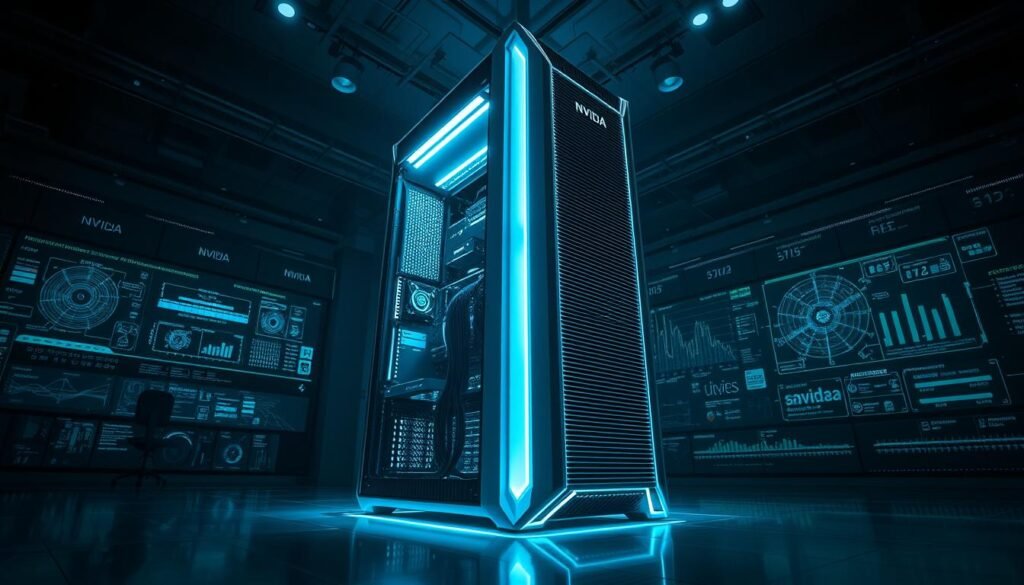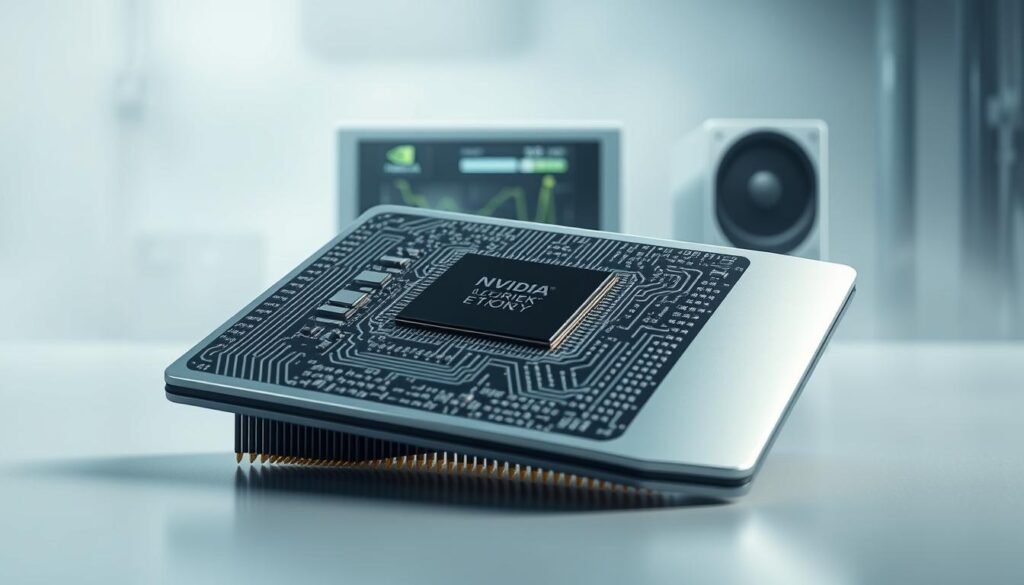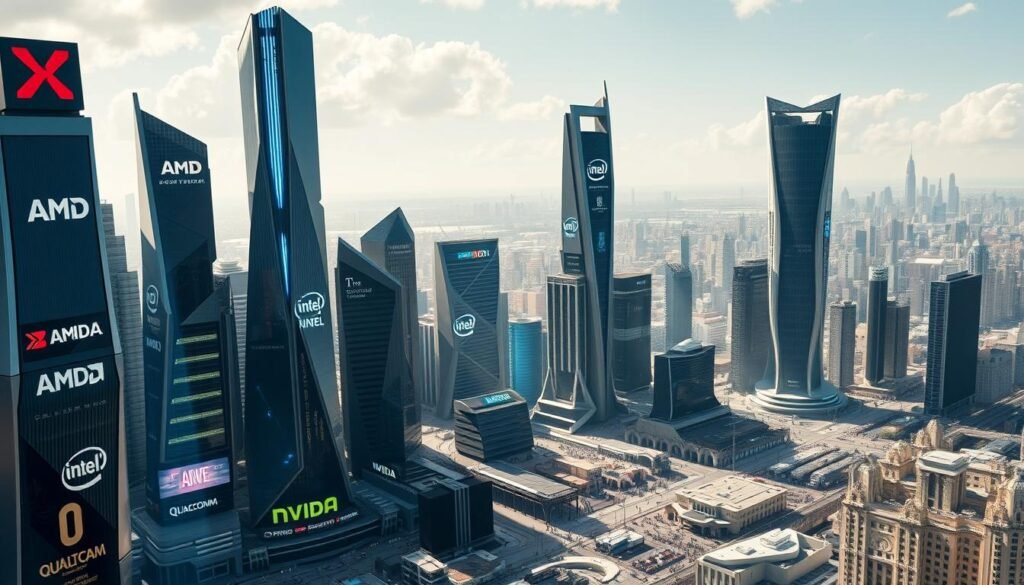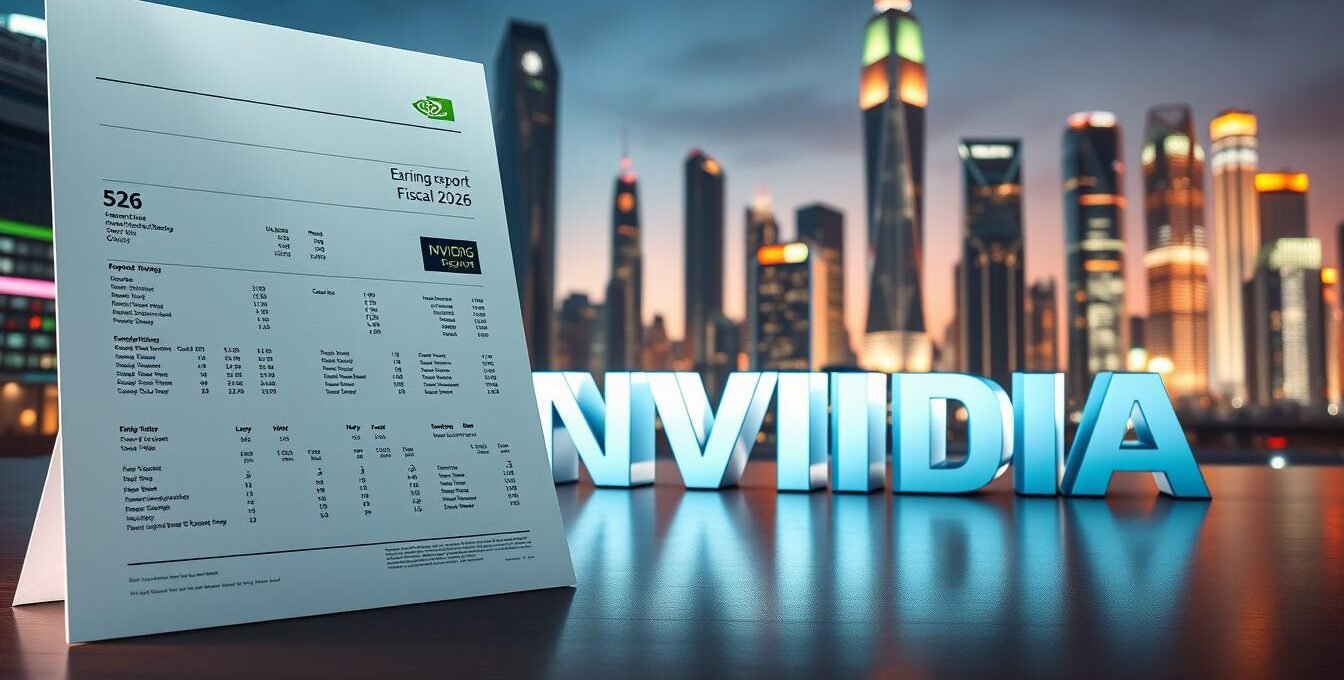NVIDIA Corporation has shared its financial results for the second quarter of fiscal year 2026. The company has achieved significant milestones and financial success. Its earnings report shows a strong performance, thanks to its leadership in the tech world.
The NVDA stock has caught a lot of attention after the financial results came out. Investors and analysts are studying the nvidia earnings report to see what it means for the company’s future.
Key Takeaways
- NVIDIA’s financial results for Q2 FY2026 show strong revenue growth.
- The company’s earnings report highlights its leadership in the tech industry.
- NVDA stock performance is being closely watched by investors.
- The financial results indicate a positive outlook for NVIDIA’s future.
- Analysts are optimistic about NVIDIA’s growth prospects.
Q2 FY26 Financial Performance Overview
NVIDIA’s Q2 FY26 financial results show a strong performance. The company has made a big impact in the tech world. Its financial numbers show it’s doing well in the market.
Record-Breaking Revenue and Profit Figures
NVIDIA hit record-breaking revenue and profit in Q2 FY26. This shows its robust financial health. Its success comes from smart moves and high demand.
Quarterly Revenue Breakdown
NVIDIA’s revenue comes from many areas, with big contributions from key segments. The data center segment is a major growth area for the company.
NVIDIA’s net income and EPS for Q2 FY26 were impressive. The EPS was much higher than before, showing NVIDIA’s profitability. This reflects its strong operations and market position.
The good financial results boosted the nvidia stock price and nvda stock price. Investors liked the earnings report. The nvidia earnings call gave more insight into the company’s plans and future, affecting the nvidia stock earnings report.
NVIDIA Stock Reaction to Q2 Earnings Report
After-hours trading saw a big change in NVIDIA’s stock as investors reacted to the company’s quarterly earnings. The release of NVIDIA’s Q2 FY26 financial results had a big impact on the stock’s performance.
After-Hours Trading Movement
In after-hours trading, NVDA stock saw a big jump, showing investor confidence in the company’s financial health. The movement was mainly because of the positive earnings report, which was better than what Wall Street expected.
The stock price went up sharply after the announcement. This trend kept going throughout the after-hours trading session. It showed a strong investor response to the earnings report.
Trading Volume Analysis
An analysis of the trading volume showed a big spike in activity during after-hours trading. The increased volume showed the market’s reaction to NVIDIA’s Q2 earnings. Investors were actively buying and selling NVDA stock.
The overall reaction to NVIDIA’s Q2 earnings report shows the company’s strong market position. As investors keep analyzing the results, the company’s stock will likely stay in the spotlight in the tech sector.
Analyst Expectations vs. Actual Results
The latest NVIDIA earnings call showed a big difference between what analysts thought and what really happened. The company shared its Q2 FY26 financial results, and everyone was eager to see how they matched up to predictions.
Wall Street Consensus Estimates
Wall Street analysts had made some guesses about NVIDIA’s revenue and earnings per share (EPS). Let’s take a closer look at these predictions.
Revenue Expectations
Analysts thought NVIDIA’s revenue would be about $28 billion. But, the company actually made $30 billion, beating expectations by $2 billion. This big win shows NVIDIA’s strong market position and growth.
EPS Projections
People thought NVIDIA’s EPS would be around $0.65. But, NVIDIA’s EPS was $0.68, beating expectations. This shows NVIDIA’s profits are better than expected.
NVIDIA’s CEO, Jensen Huang, said in the earnings call,
“Our Q2 results show the power of our GPU architecture and our drive for innovation in tech.”
The results have made investors very happy. Many are asking: did NVIDIA beat earnings? Yes, NVIDIA did more than just beat earnings; they also made more money than expected.
Segment-by-Segment Performance Analysis
NVIDIA’s success comes from its diverse business segments. Each segment has grown significantly, boosting the company’s revenue.
Data Center Revenue Growth
NVIDIA’s data center segment has been a big revenue driver. The need for NVIDIA data center solutions is growing fast.
The NVIDIA data center revenue has jumped up. This is because more companies are using cloud computing and AI. These areas are key to NVIDIA’s success.
AI Computing Platform Sales
Sales of NVIDIA’s AI computing platforms have also grown a lot. These NVIDIA AI platforms are used in many fields. This includes healthcare, finance, and the automotive industry.

NVIDIA’s enterprise solutions are doing well too. They meet the needs of big companies. These solutions help companies work better and faster.
The company’s enterprise solutions segment is growing fast. This is thanks to the use of NVIDIA’s data center and AI platforms.
Executive Commentary on Quarterly Results
NVIDIA’s CEO, Jensen Huang, talked about the company’s Q2 FY26 results. He highlighted big steps forward in AI technology. The results showed NVIDIA’s strong market position, thanks to its AI solutions.
CEO Jensen Huang’s Strategic Insights
Jensen Huang talked about NVIDIA’s focus on AI and its role in the company’s growth. “We’re seeing unprecedented demand for our AI computing platforms,” he said.
“The demand for NVIDIA’s AI computing platforms is unprecedented, driven by the need for faster and more efficient processing of complex AI workloads.”
AI Market Observations
NVIDIA has seen a big move towards AI-driven computing. Its data center revenue has grown a lot because of its Hopper and Blackwell architectures.
Jensen Huang shared NVIDIA’s long-term plans. The company aims to grow its AI abilities and improve its computing platforms. NVIDIA is ready to keep leading in the AI market.
| Key Areas | Q2 FY26 Highlights | Impact on NVIDIA |
|---|---|---|
| AI Computing | Significant advancements in AI technology | Enhanced market position |
| Data Center Revenue | Substantial growth driven by Hopper and Blackwell architectures | Increased revenue and market share |
| Long-term Vision | Expansion of AI capabilities and computing platforms | Continued leadership in AI market |
NVIDIA’s strong Q2 FY26 results and focus on AI set the stage for its future success. The company is well-positioned in the fast-changing tech world.
AI Chip Demand and Production Updates
NVIDIA’s AI chip demand has skyrocketed in recent quarters. This is thanks to the growing use of its Hopper and Blackwell architectures. NVIDIA’s leadership in AI computing is clear.
The company’s ability to innovate and deliver top-notch AI solutions has been key to its success. This has made NVIDIA a leader in the field.
Hopper and Blackwell Architecture Adoption Rates
The Hopper architecture has been widely adopted by data centers and cloud service providers. It’s known for its high performance and efficiency. The Blackwell architecture, which came after Hopper, has also seen a lot of adoption.
Especially among enterprise customers looking to upgrade their AI infrastructure. This shows the architectures’ value and appeal.
Cloud Service Provider Deployments
Cloud service providers have been quick to adopt NVIDIA’s Hopper and Blackwell architectures. They’ve integrated NVIDIA’s GPUs into their systems. This offers enhanced AI computing capabilities to their customers.
The need for more powerful and efficient AI processing has driven this adoption. It’s a big step forward for cloud services.
Enterprise Customer Implementation
Enterprise customers have also been implementing NVIDIA’s Hopper and Blackwell architectures in their data centers. They’re looking to improve AI workloads and enhance data analytics.
They also want to support complex AI models. The architectures have been praised for their scalability and performance.

| Architecture | Adoption Rate | Key Features |
|---|---|---|
| Hopper | High | High performance, efficiency |
| Blackwell | Rapidly increasing | Enhanced AI computing, scalability |
The demand for NVIDIA’s AI chips is expected to keep growing. This is thanks to the ongoing adoption of its latest architectures. As AI technology evolves, NVIDIA is set to remain a leader in AI computing.
Q3 FY26 Guidance and Forward Outlook
Investors are eager to see NVIDIA’s Q3 FY26 guidance. They want to know where the company is headed. NVIDIA’s financial plans give us a peek into its growth and strategy.
Revenue Projections for Coming Quarter
NVIDIA expects a big jump in revenue for Q3 FY26. This is thanks to strong demand for its products and services. The data center revenue is expected to lead the way, with more people using AI and cloud computing.
Segment-Specific Forecasts
NVIDIA will share detailed revenue forecasts for different areas. These include:
- Data Center: Growth from AI and cloud computing
- Gaming: Changes due to seasonal sales and new products
- Professional Visualization: More demand for top-notch graphics
Seasonal Factors Affecting Guidance
Several seasonal factors might affect NVIDIA’s Q3 FY26 guidance. These include:
- Changes in gaming console sales
- Fluctuations in OEM demand
- New product launch cycles
NVIDIA’s guidance will also be shaped by wider trends. This includes the growth of AI technologies and the need for
Looking at NVIDIA’s Q3 FY26 guidance helps investors understand the company’s plans. It shows how well NVIDIA can handle the tech world and find new chances.
Wall Street Analyst Reactions
NVIDIA’s Q2 FY26 financial results have sparked different opinions from Wall Street analysts. Many firms have changed their views on NVIDIA stock, thanks to the company’s impressive earnings.
Rating Changes Following Earnings
Analysts have given NVIDIA mixed reviews after its earnings. This shows the complexity of NVIDIA’s financial situation. The changes in ratings are important for understanding how the market sees NVIDIA’s future.
Upgrades and Downgrades
Some analysts have raised their ratings for NVIDIA stock. They point to the company’s record-breaking revenue and strong data center growth. On the other hand, a few have lowered their ratings, worried about the semiconductor industry’s challenges.
Consensus Rating Update
The consensus rating for NVIDIA stock has seen a small change after the earnings report. The overall feeling is positive, with many analysts sticking to their buy or outperform ratings. The average target price has also been updated, showing analysts’ new expectations for NVIDIA’s future.
As the market processes NVIDIA’s Q2 FY26 earnings, the reactions from Wall Street analysts are being watched closely. The nvidia stock rating and nvda rating will be key to follow. They will give insights into NVIDIA’s path and investor mood.
The varied opinions from analysts highlight the fast-changing tech sector. Companies like NVIDIA must keep innovating to stay ahead. As Wall Street analyst reactions keep coming, they will shed light on NVIDIA’s strategies and market standing.
Strategic Initiatives and Business Highlights
NVIDIA is focusing on growth through innovation. They have introduced new initiatives. These moves aim to strengthen their position in the tech world and boost future growth.
New Product Announcements
NVIDIA has been introducing nvidia new products to meet market needs. These products bring advanced technology and better performance.
Hardware Innovations
The company’s nvidia hardware innovations include better GPU technology. This is key for gaming, professional visualization, and data centers. For example, NVIDIA’s latest GPUs offer better performance and use less power.
| Product | Key Features | Applications |
|---|---|---|
| NVIDIA GeForce RTX 40 Series | Improved ray tracing, AI-enhanced graphics | Gaming, Content Creation |
| NVIDIA Hopper Architecture | Enhanced performance, scalability | Data Centers, AI Computing |
Software and Platform Updates
NVIDIA is also updating their nvidia software updates to improve user experience. Their software platforms, like NVIDIA Omniverse, provide powerful tools for professionals.
NVIDIA’s strategic moves show their dedication to innovation and customer satisfaction. By continually advancing technology, NVIDIA is set to lead in the tech industry.
Competitive Landscape and Market Position
NVIDIA’s quarterly earnings highlight its battle with AMD and Intel. Its leading GPU technology and AI chip market share define its market position.

AMD and Intel Competitive Dynamics
AMD is making waves with Ryzen and EPYC processors, challenging Intel in CPUs. NVIDIA’s GPUs lead the market, with AMD’s Radeon GPUs as competitors.
NVIDIA’s edge comes from its software, like CUDA, which is key for GPU acceleration. Intel’s Xe architecture is a step forward, but NVIDIA is ahead.
Cloud Provider In-House Chip Developments
Cloud providers are making their own chips to cut down on NVIDIA and others. This move is both a hurdle and a chance for NVIDIA in cloud computing.
“The development of custom chips by cloud providers is a significant trend that will shape the future of the semiconductor industry,” said Jensen Huang, CEO of NVIDIA.
NVIDIA is adapting by boosting partnerships with cloud providers and creating new products for them.
Regulatory and Macroeconomic Considerations
Regulations and the economy greatly affect NVIDIA’s business. The company deals with many issues like export controls and market restrictions. These can change how well it does financially.
Export Control Impacts
NVIDIA faces strict export controls. These rules can stop it from selling in some places. Governments use these controls to keep sensitive tech from the wrong hands.
China Market Restrictions
The China market is big for NVIDIA, but it’s limited by export controls. These rules can block NVIDIA from reaching many customers.
Alternative Market Development
NVIDIA is looking at new markets and ways to work around export controls. It’s trying to find new customers and make products that meet rules.
NVIDIA is working hard to stay ahead in the tech world. It’s tackling tough regulations and economic issues to keep growing.
Impact on Broader Semiconductor and Tech Sectors
NVIDIA’s Q2 financials have big effects on the semiconductor and tech worlds. Their record revenue and profits mean a lot for the industry.
Semiconductor Industry Implications
The semiconductor world closely follows NVIDIA’s success. NVIDIA’s impact touches many areas, from chip design to making processes.
Supply Chain Ripple Effects
The supply chain ripple effects of NVIDIA’s success are seen across the industry. Suppliers of important parts, like memory and substrates, are changing their production to meet NVIDIA’s needs.
Industry Growth Projections
Thanks to NVIDIA’s strong showing, growth forecasts for the industry are going up. The semiconductor industry is set to keep growing, driven by AI, data center, and car tech needs.
![]()
The tech sector is also watching NVIDIA’s results closely. They affect cloud computing, gaming, and professional visualization markets. As tech keeps changing, NVIDIA’s role in shaping the semiconductor world will stay important.
Conclusion: NVIDIA’s Q2 Performance and Future Trajectory
NVIDIA’s Q2 results show the company is doing well in the tech world. They had record revenue and profits. The growth in data center revenue and the use of new AI chips highlight NVIDIA’s leadership.
The company is set for more growth in the next quarter. NVIDIA is making new products and improving its position in the market. This will help them stay ahead of competitors.
NVIDIA’s Q2 earnings report gives us a peek into their current and future success. People who invest in the company and follow tech news will watch NVDA stock closely. They want to see how NVIDIA is doing.
NVIDIA’s success also affects the wider tech and semiconductor industries. It shows what’s happening in these fields and how companies are competing.
FAQ
What were NVIDIA’s Q2 FY26 earnings results?
NVIDIA had a great quarter, with record revenue and profit. This was thanks to high demand for its data center and AI computing platforms.
How did NVIDIA’s stock react to the Q2 earnings report?
After the earnings report, NVIDIA’s stock saw big changes. The price and volume moved based on the company’s financials and future plans.
Did NVIDIA beat analyst expectations for Q2 FY26?
Yes, NVIDIA did better than expected in key areas. They beat Wall Street’s guesses for revenue and EPS.
What were the key drivers of NVIDIA’s data center revenue growth?
NVIDIA’s data center revenue grew thanks to its AI platforms. The Hopper and Blackwell architectures were big hits with cloud and enterprise customers.
What is NVIDIA’s guidance for Q3 FY26?
NVIDIA shared its revenue outlook for the next quarter. They talked about specific segments and how seasonal factors might affect their numbers.
How did Wall Street analysts react to NVIDIA’s Q2 earnings report?
Analysts made changes to their ratings after NVIDIA’s report. This led to an updated consensus rating for the stock.
What are the implications of NVIDIA’s performance for the broader semiconductor industry?
NVIDIA’s results have big implications for the semiconductor world. They affect supply chains and growth projections.
How does NVIDIA’s competitive landscape look like?
NVIDIA faces tough competition from AMD, Intel, and cloud providers. These rivals can challenge NVIDIA’s market share.
What are the regulatory and macroeconomic considerations affecting NVIDIA?
NVIDIA deals with export controls and China market restrictions. They’re working on strategies to overcome these challenges.
When does NVIDIA report its next earnings?
You can find NVIDIA’s next earnings report date on their investor relations website or through financial news.
What is NVIDIA’s long-term vision for the AI market?
NVIDIA’s CEO, Jensen Huang, shared his vision for AI. He talked about the company’s goals and its role in the industry.



Leave a Comment